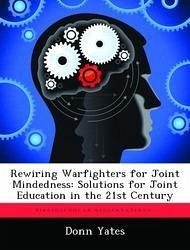Nicht lieferbar

Rewiring Warfighters for Joint Mindedness: Solutions for Joint Education in the 21st Century
Versandkostenfrei!
Nicht lieferbar
Despite the efforts of the Goldwaters Nichols Act of 1986, jointness continues to be a problem in the Department of Defense. Scholars point to both organizational and cultural problems as the root of the problem, but these explanations are incomplete. People comprise organization and people use culture as means of to explain identity, norms, and behavior. The individual level of analysis emerges as another explanation to the problem of jointness in order to complement the other two. In order to do this, the author uses the P2C framework as a means to develop joint-mindedness through the develo...
Despite the efforts of the Goldwaters Nichols Act of 1986, jointness continues to be a problem in the Department of Defense. Scholars point to both organizational and cultural problems as the root of the problem, but these explanations are incomplete. People comprise organization and people use culture as means of to explain identity, norms, and behavior. The individual level of analysis emerges as another explanation to the problem of jointness in order to complement the other two. In order to do this, the author uses the P2C framework as a means to develop joint-mindedness through the development of cognitive symmetry between officers from different services. P2C represents three elements: perspective, perception, and context. Cognitive symmetry occurs during the alignment of these three elements between individuals. Mistaken perspective, misperception, and faulty context create conditions for cognitive asymmetry which leads to problems with jointness. The current DOD Joint Qualification System (JQS) does not facilitate joint-mindedness. This system uses points and qualification levels to accredit prospective officers as joint qualified officers (JQO) but makes no provision to make them joint-minded. Additionally, the system gives the impression that joint qualification is a means for promotion to higher rank and not a method to inculcate jointness among the service branches. The author uses four Joint Environment Opportunities (JEO) for analysis of the current JQS: education, operations, staffwork, and training. The author evaluates each JEO against five criteria. The criteria are opportunity, frequency, perspective, perception, and context. From this analysis, education emerges as the best venue to develop joint-mindedness within the DOD. To facilitate this new approach, the author proposes three recommendations for joint education.





